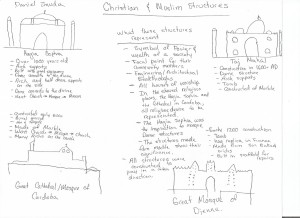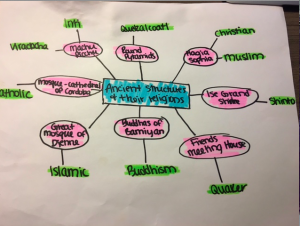I decided to look at the religious structures. More specifically, I just looked at the religious structures mainly from the religions of Christianity and Islam. I analyzed the reading from class, watched the videos on the structures, and did additional research. On my concept map, I have each individual structure; Hagia Sophia, Great Cathedral of Cordoba, Taj Mahal, Great Mosque of Djenne. Under the structures I have some basic facts about them, when they were constructed, what they were made out of, what religion they were apart of, and the structure that they were made from. In the middle of my concept map, I have what these structures represent for their society. For each of the structures I analyzed, they represented and continue to represent wealth and power of their society. Some of these structures have been conquered by opposing religions because of their significance. I learned the Hagia Sophia was an inspiration to the Dome style of mosques, I also learned that the way that the buildings were designed was so that everyone could pray facing the same way. The architecture for the Hagia Sophia was a dome that came down on a square, it was an incredibly difficult structure to engineer. The Taj Mahal was built nearly the same way as the Hagia Sophia was. Many of these structures were built from marble, which signifies how important these structures were to the community.
Concept Map
In my concept map, I decided to look at the different religions practiced at the sacred structures we went over in class. I have read about each religion, but had not compared them all. In the case of ancient religions such as the Aztec and Incans, they practiced concepts more than particular religions; they worshipped many gods, believed in human sacrifice, and their sacred structures were built to recognize particular gods. Hagia Sophia was a Christian and Muslim place of worship at different times, and served the dual purpose of a cultural center. People at Ise Grand Shrine practice Shinto, and it is an extremely sacred structure. The Friends Meeting houses were “sacred” structures of the Quakers. Unlike the other grand structures, Quaker houses were very plain and simple. The Buddhas of Bamiyan statues held importance for people of the Buddhist religion, and were almost completely destroyed. The Great Mosque of Djenne is an Islamic center, and also serves as an important cultural center. Finally, the Mosque- Cathedral of Cordoba is a site of Catholic religion. In my comparison, I found that the majority of religious structures were very elaborate buildings. They exhibit some of the greatest architecture of the civilizations of the time, and many stand to this day because of it. Many of the structures also served as great community centers and places of learning aside from their religious purpose.
Module 6: Concept map
Okay so looking at the prezi that is linked in this post you can see it is a bit vague, don’t worry I plan on going in depth with it. First off the point of the concept map, in true Agerbeck fashion, is to help me to write these few paragraphs all about what values and habits were in common between these three sacred locations. The values being looked at are those at the time of the sacred location’s use and how those values have changed to modern day.
Looking at the big picture first, they all have religion tightly involved in why they are what they are. The next step after that was to break it down into what I felt were good subtopics, sacred grounds or sacred structures. The reason for this break down is due to Machu Picchu. Machu Picchu isn’t a temple, mosque or a church, it is in fact a whole city that has values placed in each section it is divided into. Shortly after that I needed to talk about the materials that are involved this is to help relate each building together with something that is a pivotal point of each location. Looking at the Hagia Sophia we can see that it is a large structure similar to the Aztec’s temples, where religious practices took place. Now on the flip side Machu Picchu isn’t just a place to pray it also came with the values of agriculture similar to how the Aztec temples are. Knowing that the values for the Inca’s Machu Picchu and the Aztec’s you can see that their religion was so similar even though comparing and contrasting, they are in two different continents.
Now lets look at the final bit, the values that are present today in these locations are all about the amazing feats. The Inca’s were amazing stone craftsmen, the Aztec’s were devoted natives, and the Hagia Sophia was a feat. with a value in its history. The commonalities are the values, for example the value we place in all of the locations, is for the fact that they are all standing artifacts that allow us to dive into the past with a promise to continue showing all their value as long as they stand.
